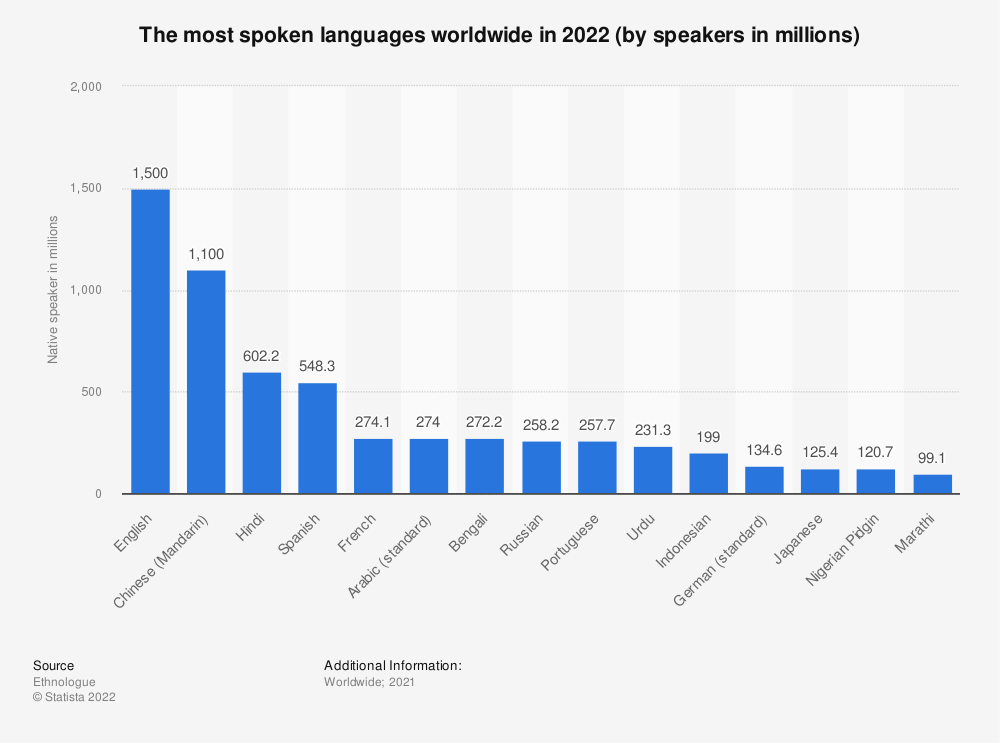Home » Multilingual Customer Support » 8 Benefits of Providing Multilingual Customer Support
8 Benefits of Providing Multilingual Customer Support
- | Amit Shivani

Table of Contents
The basics of business is to stay as close as possible to your customers—understand their behavior, preferences, purchasing patterns, etc.
Indra Nooyi
The big question when it comes to customer service is: how do you stay close to your customers to understand their preferences, behaviour, and so forth?
According to an Intercom survey, 70% of customers stay loyal to companies offering customer support in their native tongue. Speaking to customers in their native language helps you connect with them on a more personal level, and respond to their queries efficiently. That answers the biggest question regarding customer satisfaction, retention and engagement.
Now, the follow-up question that often pops up is: when you run a global business — with customers spread across the world and given that there are 7,100 languages spoken worldwide — how can you efficiently provide customer-centric and value-driven services in multiple languages?
There is a solution for all your translation and localization woes! These days, customer support teams are equipped with exceptional B2B SaaS tools to offer multilingual customer support. Yes, there’s more to customer service than meets the eye. Multilingual customer support — a feature of most translation management systems (TMS) — helps companies engage with customers in their preferred language.
Whether your customer speaks Mandarin, Spanish, Hindi, French, or Arabic, companies don’t have to hire multilingual agents to offer personalized support. The multilingual customer support feature helps you strike a perfect chord with your customers in whichever language they are most comfortable conversing in!
Why Should Businesses Use a Multilingual Customer Support System?
Approximately 72.1% of people spend all or the majority of their time on websites in their native language.
29% of businesses say they’ve lost customers because they don’t offer multilingual support.
62% are more willing to put up with product flaws if they can get help in their native language.
69% of contact centre leaders expect non-English customer volume to increase over the next five years.
Now let’s look at the benefits of offering multilingual customer support.
Interact with Customers in their Language of Choice
Customer engagement is high on the list of priorities for many organizations. Indeed, using social media, AI-powered bots, live chats, and more helps with higher customer engagement. However, multilingual customer support is the magic ingredient that takes a brand from good to excellent. It allows companies to speak to customers in the language they prefer, putting the customers’ preference first, which inadvertently gains the brand a few brownie points! Unfortunately, that is not the case with social media tools. Maybe one day, customers will be able to view your organization’s social media feed in their preferred language as well. Won’t that be something?
Needless to say, when your customer support team interacts with the customer in their preferred language, the quality of the conversation improves dramatically, and both parties can collaborate and solve issues effectively, as customers are relatively at ease and fluent in expressing their concerns clearly. Clarity, at the end of the day, is crucial.
Manage Multilingual Translations in an Omni-channel Set Up
Your company may have established an omni-channel ecosystem to support your customers, through live chats, emails, phone calls, and more. Even so, dealing with customers and offering them prompt feedback through all these channels, and that too in their native language, is not that easy.
Enter Lingpad app – an app that is pretty well-acquainted with offering tons of translations for all the customer care channels you use. The best part: it stores and organizes all translated content in one place. You won’t have to shuffle back and forth between your emails or live chats separately to offer feedback. People with access to the relevant project can go to the Lingpad dashboard, jump onto Editor, where all the localization happens, and check the translations for accuracy and approve it with a single click!
Bottom line: The multilingual customer support feature of Lingpad, which can be integrated with Zendesk and Freshdesk, is the best bet for multilingual, multichannel customer support. This means customer issues are resolved more efficiently, thereby offering companies the opportunity to resolve the topic as speedily as possible with utmost customer satisfaction.
Imagine, if these translations were done manually and that too for multiple channels, how much time would it take to solve a single customer query? Thanks to Lingpad, it automates tons of translation requirements across multiple channels, thereby enabling scalability.
Multilingual Customer Support Promotes Customer Loyalty
Listed below are few of the top Customer Loyalty Statistics as cited by SmallBizGenius:
- 56% of customers stay loyal to brands that “get them”
- 58% of companies pursue personalization strategies for customer retention
- Increasing customer retention by just 5% boosts profits by 25% to 95%
To put things in perspective, there’s nothing like it if you can speak to your customer in their native tongue. It would give the customer a “birds of the same feather flock together” feeling, wouldn’t it? This, in turn, wins their loyalty. Further, customers would perceive it as an additional effort made by your company to offer personalized services.
Win International Clientele; Skyrocket your Sales
Providing customer support in multiple languages boosts customer loyalty and gives an international clientele a reason to do business with you.
In an Intercom survey of 170 non-native English-speaking SaaS consumers, only 28% of the customers said they got support offered in their native language. There are plenty of opportunities for businesses to capitalize on this barely chartered territory, especially when 35% (as per the same survey) of customers are ready to shift loyalties if they are offered support in their native tongue.
More to the point, providing product information, company information, and customer care service across several languages promotes conversion rates, especially in countries with a high percentage of non-English speakers.
Increased Positive Feedback as a Result of Inclusive Communication
Customers invariably read reviews before making any purchase, online or offline. Turns out, 93 percent of shoppers read internet reviews before purchasing a new product. The more positive reviews you have about your product or service, the more customers believe in you.
How can multilingual customer support help, in this case, you ask?
As per a recent study, 70% of customers gave positive feedback to businesses that offer multilingual customer support. As mentioned, non-English speakers galore globally. You can easily tap into this unexplored segment and win their goodwill by providing them with customer support in their native language, thereby prompting them to leave positive feedback about your service or product on your review pages or comment section.
This is especially important if you are new to the market and you want to establish a strong presence in your sector, leading to increased sales and better brand recognition.
Customer Tolerance Towards Companies Increases
Many customers, if anything, shift loyalties to another brand due to product issues and long delays in customer assistance. Not if you offer timely, multilingual customer support. According to the same Intercom survey, customers would tolerate your product limitations if you offered them support in their native language.
Obtain a Competitive Edge
Buying decisions are not purely finance-driven. Some buyers will go for a pricier option — sometimes even pay top dollar — if it means they get exceptional service. Offering multilingual customer support, in one sense, means offering personalized support in the customers’ chosen language, which would automatically give you a leg-up over your competitors. And as mentioned, only a handful of companies have tapped into multilingual localization, which means you will have an upper-hand within the industry.
Build Reputation as a Market Leader
While English is considered as the default language in international business, a significant percentage of your customer base speaks and understands other languages – with Mandarin coming in as a close second and Hindi in the third position (Source: Berlitz). As a business with dreams to scale globally, can you let go of such a considerably wide consumer base?
So, instead of forcing buyers to adjust to you, you can offer to communicate with them in a language they’re more familiar and comfortable with by using multilingual customer support. It would help them feel prioritized and make it easier for them to do business with you, enhancing your position among your competitors as your business grows and more and more clients start doing business with you. That’s a win-win right there!
How can Lingpad help you win at Multilingualism?
On the subject of efficient TMS to optimize multilingual customer service, Lingpad is a cloud-based, AI-powered Translation Management System that supports swift translation services for multiple teams. A single source of truth for all your localization strategies — from chat support to help center articles — you can localize all brand communication, personalize it based on brand guidelines, and save it to reduce costs and increase productivity!
Let’s say your agent has received multiple customer tickets in Mandarin and Spanish. If your customer support system is working in combination with the Lingpad app, the agent automatically receives the AI-translated ticket in their preferred language to understand the query. Following this, the agent can respond to the query in their own language, within the Lingpad app and then request translation. At this stage, the agent can rely on Lingpad’s preferred network of professional, human Language Service Providers who can help answer the query in linguistically and culturally-accurate Mandarin and Spanish.
Plus, you can organize and store all your translated files in one place. And the best part is that you can effortlessly integrate Lingpad with your existing customer support software. If these weren’t enough, the app helps localize more than 40 types of files.
Currently, if you are using either of the two customer support software, be it Freshdesk or Zendesk, you can effortlessly integrate the Lingpad App to engage with customers in their native language. You can download the Lingpad app for Freshdesk and Zendesk from their respective marketplaces. By integrating the Lingpad App for Zendesk and the Lingpad App for Freshdesk, your customer support team will be perfectly equipped to manage communication in over 180 languages.
If your business has a global footprint or is on the verge of going global, let’s discuss a few stats and facts that will help you decide whether or not to use multilingual customer support.
Lingpad’s Multilingual Customer Support Feature is a Must for Businesses Going Global
With the world being a level playing field for all businesses, integrating the Lingpad app with your customer support system could prove to be a crucial cog in your customer support wheel as it would enable you to engage with your customers personally in their native tongue. The multilingual support system feature of the Linpad app will help you solve queries and customer concerns without much ado. This means you will be able to retain customers and win their loyalty for a lifetime, expand your business worldwide and propel sales globally.

Amit Shivani
Amit Shivani is the Director of Sales at Lingpad. His superpower is bridging the gap between client needs and wants along with the sheer determination to redefine sales. Working with various brands to tackle their localization demands brings out his out-of-box, innovative persona. When he is not helping clients achieve expertise-status in their localization journey, he explores cities and street food and works towards gaining expertise-status for himself in photography.
Share this blog:


